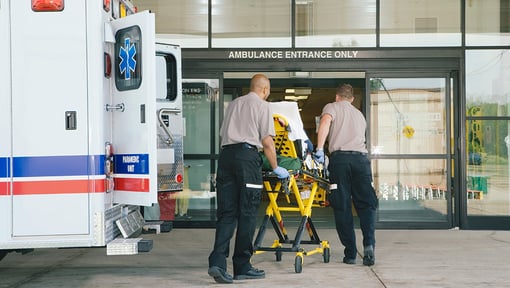The brain is a complex organ that can only function when it has a nonstop supply of oxygen-rich blood and nutrients. Even a brief disruption of blood flow can cause damage to the brain. A stroke is one of the more common reasons this may happen.
Strokes occur when arteries to the brain narrow too much, or a blood clot blocks the flow of blood to the brain. It is vital that you seek emergency medical care right away. The sooner you can get to a hospital, the more likely it is you’ll be able to recover from the effects of a stroke. Getting to a doctor right away also means you’re less likely to experience permanent damage from a stroke.
That’s why it’s so important to recognize the symptoms of a stroke. If you don’t know what to look for, you may not even realize it is a stroke. Not every stroke is severe. This can lead some people to wait for symptoms to pass.
Waiting, however, can be risky.
It’s vital to get care as soon as you can. Even a mild stroke requires medical attention.
Strokes can be treatable, but time is of the essence. The sooner you seek treatment, the better your chances that you’ll recover with little to no disability.
According to the American Stroke Association, patients treated with a clot-busting drug within 90 minutes of a stroke were nearly 3 times more likely to recover without permanent damage.
Unfortunately, if you wait too long, doctors cannot give you a clot-busting drug. This type of drug must be given to patients within 3 to 4 hours of the stroke. If the drug is administered outside that window of time, it may thin the blood too much and possibly lead to a life-threatening brain bleed.
Stroke Symptoms: Think F.A.S.T.
So, if you’re unsure what the signs and symptoms of stroke are, just remember the acronym F.A.S.T.
F is for Face drooping
- Is one side of your face numb or drooping? Try smiling to see if one side responds less than the other. If you’re assessing someone else for stroke, ask them to smile and then watch whether one side droops.
A is for Arm weakness
- Does one arm feel weak or numb? Try to raise both arms and watch to see if one arm droops or sags down. If you’re assessing someone else, ask them to raise their arms and watch to see if one arm remains lower.
S is for Speech difficulty
- Is speech slurred at all? Is it difficult to talk? If you’re assessing someone else, ask them to speak to you and listen for slurred or labored speech.
T is for Time to call 9-1-1
- If you’ve answered yes to any of the above questions, it’s time to call 9-1-1.
Aside from the symptoms related to F.A.S.T., here are a few other symptoms to watch for. If any of these symptoms come on suddenly, it may be a sign of stroke and you should call 9-1-1.
- Numbness. There may be sudden signs of numbness to part of your face, arms, or legs. Take note if the numbness is only occurring on one side of your body.
- Confusion. You might have trouble speaking or understanding someone else speak.
- Walking problems. You may feel dizzy or have a loss of balance or coordination.
- Difficulty seeing. Your vision may suddenly be impaired in one or both eyes.
- Severe headache. A painful headache may come on with no cause.

Call 9-1-1 … Do not drive to the hospital
Here’s an important tip if you think you or someone you know is having a stroke: Call 9-1-1 first. Do not drive to the hospital. Emergency dispatchers will send for an ambulance.
Remember, time is of the essence when it comes to stroke. You may feel like you’ll save time driving to the hospital, but here’s why you shouldn’t:
- An ambulance is like bringing the hospital to you. The emergency medical crew may even be able to start administering clot-busting medication right then and there.
- Emergency vehicles have the right of way. The ambulance’s sirens will clear any traffic on the way to the hospital.
- You’ll be treated much more quickly once you get to the hospital. The emergency crew will call ahead to let medical teams know a stroke patient is incoming. They’ll also complete any other preliminary tests on the way.
- Not all hospitals specialize in stroke care. While every hospital will treat you if you’re having a stroke, certain hospitals specialize in stroke care and will be better equipped to handle your emergency. The ambulance crew will know which hospital is right for you.
- You might not be in the right frame of mind. This is especially true if you are personally experiencing stroke symptoms. It is not safe for you to drive a vehicle in such a case. Even if you’re driving someone else who is having a stroke, you might feel panicked and drive more recklessly than usual.
Learn more about which hospitals near you have comprehensive stroke centers.
A stroke can be incredibly dangerous and even deadly. But it doesn’t have to be. Learning to recognize the signs of stroke can make a big difference. If you can think quickly and get immediate help, you may just help prevent more serious harm.
Not a Silver&Fit® member? Learn more about everything the program has to offer, including more helpful healthy living tips like this, here on our website.
This information is not intended to take the place of regular medical care or advice. Please check with your doctor before using this information or beginning any self-care program. Images used for this article do not depict any members of the Silver&Fit Program.
References
American Heart Association. (n.d.) American Stroke Association. http://www.strokeassociation.org/STROKEORG/
MedStar Health. (2020, August 26). Signs of stroke? Why you need to get to the ER fast. https://www.medstarhealth.org/blog/signs-of-stroke-why-you-need-to-get-to-the-er-fast
Feng, Q., Fan, S., Wu, Y., Zhou, D., Zhao, R., Liu, M., & Song, Y. (2018). Adherence to the dietary approaches to stop hypertension diet and risk of stroke: A meta-analysis of prospective studies. Medicine (Baltimore), 97(38), e12450. https://doi.org/10.1097/MD.0000000000012450
Mayo Clinic. (2023, December 13). Stroke. https://www.mayoclinic.org/diseases-conditions/stroke/symptoms-causes/syc-20350113
National Institute of Neurological Disorders and Stroke. (2018). Stroke information page: Know stroke. https://www.ninds.nih.gov/Disorders/All-Disorders/Stroke-Information-Page
Paterson, K. E., Myint, P. K., Jennings, A., Bain, L. K. M., Lentjes, M. A. H., Khaw, K. T., & Welch, A. A. (2018). Mediterranean diet reduces risk of incident stroke in a population with varying cardiovascular disease risk profiles. Stroke, 2415-2420. https://doi.org/10.1161/STROKEAHA.117.020258
This article was written by Jason Nielsen, edited by Candace Hodges, MS, and clinically reviewed by Elizabeth Thompson, MPH, RDN, on June 4, 2025.





